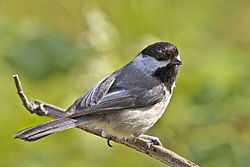Irishtown Nature Park, New Brunswick
| Irishtown Nature Park | |
|---|---|
|
A black-capped chickadee, the most common bird in the park. | |
| Type | Urban park |
| Location | Moncton, New Brunswick |
| Area | 22,000 acres (8,900 ha) |
| Operated by | City of Moncton |
| Status | Open all year |
This article refers to a park in Canada. If you are looking for information about a park in Dublin, see Irishtown Nature Park, Dublin.
Irishtown Nature Park is a large urban park located in the Northern Edge Within the city of Moncton, New Brunswick (Tankville). At 9 km2 it is one of the largest urban parks in Canada. The park has a large (1.20 km2) lake which is popular for kayaking and canoeing. The park is also used for hiking, mountain biking and cross-country skiing in the winter. There are several historic displays within the park including a small museum consisting of a fully restored one-room school. There is also a set of signs relating to the parks history as the city of Monctons first water supply dating back to the mid 19th century
Birdwatching is popular in the park due to the wide variety of birds which reside in the park including:
- Black-capped chickadees
- Nuthatches
- Yellow-finches
- Purple Finches
- Hairy woodpeckers
- Downy woodpeckers
- Doves
The red trail (4.7 km) starts at the main parking lot on Elmwood drive and circles inside park boundaries. This trail is surfaced which makes it accessible for all to walk, groomed in the winter as well for walking. This multiuse trail is used by walkers, runners, wheel chairs, bikers and hikers.
The yellow trail (5.8 km) also begins in the main parking lot see park entrance signage. This trail is a more natural trail made for the adventurer that runs along the lake some sections where it is wet have been chipped for easier access. This trail is used by hikers, walkers and snowshoers in the winter.
The blue trail (1.1 km) is a nature trail that begins in a maturing hemlock forest and runs through various other forest stands that are typically found in the Acadian Forest. This trail is used for outdoor science-based education/interpretation as there is so much to explore on this trail.
See also
- List of parks in New Brunswick
References
| ||||||||||||||||||||||||||||||||||||||
| ||||||||||||||||||||||||||
46°08′29″N 64°46′22″W / 46.1414°N 64.772823°WCoordinates: 46°08′29″N 64°46′22″W / 46.1414°N 64.772823°W
